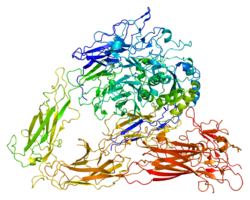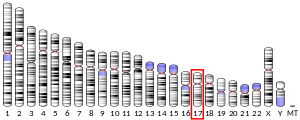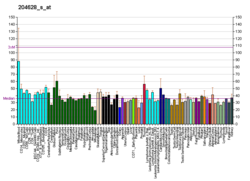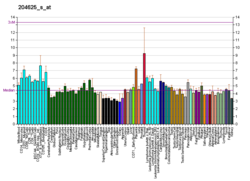Integrin beta-3 (β3) or CD61 is a protein that in humans is encoded by the ITGB3 gene.[5] CD61 is a cluster of differentiation found on thrombocytes.[6]
Structure and function
editThe ITGB3 protein product is the integrin beta chain beta 3. Integrins are integral cell-surface proteins composed of an alpha chain and a beta chain. A given chain may combine with multiple partners resulting in different integrins. Integrin beta 3 is found along with the alpha IIb chain in platelets. Integrins are known to participate in cell adhesion as well as cell-surface-mediated signaling.[7]
Role in endometriosis
editDefectively expressed β3 integrin subunit has been correlated with presence of endometriosis, and has been suggested as a putative marker of this condition.[8]
Interactions
editCD61 has been shown to interact with PTK2,[9][10] ITGB3BP,[11][12] TLN1[13][14] and CIB1.[15]
See also
editReferences
edit- ^ a b c GRCh38: Ensembl release 89: ENSG00000259207 – Ensembl, May 2017
- ^ a b c GRCm38: Ensembl release 89: ENSMUSG00000020689 – Ensembl, May 2017
- ^ "Human PubMed Reference:". National Center for Biotechnology Information, U.S. National Library of Medicine.
- ^ "Mouse PubMed Reference:". National Center for Biotechnology Information, U.S. National Library of Medicine.
- ^ Sosnoski DM, Emanuel BS, Hawkins AL, van Tuinen P, Ledbetter DH, Nussbaum RL, et al. (June 1988). "Chromosomal localization of the genes for the vitronectin and fibronectin receptors alpha subunits and for platelet glycoproteins IIb and IIIa". The Journal of Clinical Investigation. 81 (6): 1993–1998. doi:10.1172/JCI113548. PMC 442653. PMID 2454952.
- ^ Heemskerk JW, Mattheij NJ, Cosemans JM (January 2013). "Platelet-based coagulation: different populations, different functions" (PDF). Journal of Thrombosis and Haemostasis. 11 (1): 2–16. doi:10.1111/jth.12045. PMID 23106920. S2CID 206157070.
- ^ "Entrez Gene: ITGB3 integrin, beta 3 (platelet glycoprotein IIIa, antigen CD61)".
- ^ May KE, Villar J, Kirtley S, Kennedy SH, Becker CM (2011). "Endometrial alterations in endometriosis: a systematic review of putative biomarkers". Human Reproduction Update. 17 (5): 637–653. doi:10.1093/humupd/dmr013. PMID 21672902.
- ^ Eliceiri BP, Puente XS, Hood JD, Stupack DG, Schlaepfer DD, Huang XZ, et al. (April 2002). "Src-mediated coupling of focal adhesion kinase to integrin alpha(v)beta5 in vascular endothelial growth factor signaling". The Journal of Cell Biology. 157 (1): 149–160. doi:10.1083/jcb.200109079. PMC 2173263. PMID 11927607.
- ^ Chung J, Gao AG, Frazier WA (June 1997). "Thrombspondin acts via integrin-associated protein to activate the platelet integrin alphaIIbbeta3". The Journal of Biological Chemistry. 272 (23): 14740–14746. doi:10.1074/jbc.272.23.14740. PMID 9169439.
- ^ Fujimoto TT, Katsutani S, Shimomura T, Fujimura K (January 2002). "Novel alternatively spliced form of beta(3)-endonexin". Thrombosis Research. 105 (1): 63–70. doi:10.1016/S0049-3848(01)00405-4. PMID 11864709.
- ^ Shattil SJ, O'Toole T, Eigenthaler M, Thon V, Williams M, Babior BM, et al. (November 1995). "Beta 3-endonexin, a novel polypeptide that interacts specifically with the cytoplasmic tail of the integrin beta 3 subunit". The Journal of Cell Biology. 131 (3): 807–816. doi:10.1083/jcb.131.3.807. PMC 2120613. PMID 7593198.
- ^ Patil S, Jedsadayanmata A, Wencel-Drake JD, Wang W, Knezevic I, Lam SC (October 1999). "Identification of a talin-binding site in the integrin beta(3) subunit distinct from the NPLY regulatory motif of post-ligand binding functions. The talin n-terminal head domain interacts with the membrane-proximal region of the beta(3) cytoplasmic tail". The Journal of Biological Chemistry. 274 (40): 28575–28583. doi:10.1074/jbc.274.40.28575. PMID 10497223.
- ^ Calderwood DA, Yan B, de Pereda JM, Alvarez BG, Fujioka Y, Liddington RC, et al. (June 2002). "The phosphotyrosine binding-like domain of talin activates integrins". The Journal of Biological Chemistry. 277 (24): 21749–21758. doi:10.1074/jbc.M111996200. PMID 11932255.
- ^ Naik UP, Patel PM, Parise LV (February 1997). "Identification of a novel calcium-binding protein that interacts with the integrin alphaIIb cytoplasmic domain". The Journal of Biological Chemistry. 272 (8): 4651–4654. doi:10.1074/jbc.272.8.4651. PMID 9030514.
Further reading
edit- Bray PF (October 1994). "Inherited diseases of platelet glycoproteins: considerations for rapid molecular characterization". Thrombosis and Haemostasis. 72 (4): 492–502. PMID 7878622.
- Bennett JS (2001). "Platelet-fibrinogen interactions". Annals of the New York Academy of Sciences. 936 (1): 340–354. Bibcode:2001NYASA.936..340B. doi:10.1111/j.1749-6632.2001.tb03521.x. PMID 11460491. S2CID 25431334.
- Sajid M, Stouffer GA (February 2002). "The role of alpha(v)beta3 integrins in vascular healing". Thrombosis and Haemostasis. 87 (2): 187–193. doi:10.1055/s-0037-1612971. PMID 11858476.
- Quinn MJ, Byzova TV, Qin J, Topol EJ, Plow EF (June 2003). "Integrin alphaIIbbeta3 and its antagonism". Arteriosclerosis, Thrombosis, and Vascular Biology. 23 (6): 945–952. doi:10.1161/01.ATV.0000066686.46338.F1. PMID 12637342.
- Charakida M, Tousoulis D, Stefanadis C, Toutouzas P (January 2003). "The impact of platelet glycoprotein IIIa and Ia polymorphisms in cardiovascular thrombotic disease". Italian Heart Journal. 4 (1): 17–22. PMID 12690916.
- Smith FB, Connor JM, Lee AJ, Cooke A, Lowe GD, Rumley A, et al. (2004). "Relationship of the platelet glycoprotein PlA and fibrinogen T/G+1689 polymorphisms with peripheral arterial disease and ischaemic heart disease". Thrombosis Research. 112 (4): 209–216. doi:10.1016/j.thromres.2003.11.010. PMID 14987913.
- Fullard JF (2004). "The role of the platelet glycoprotein IIb/IIIa in thrombosis and haemostasis". Current Pharmaceutical Design. 10 (14): 1567–1576. doi:10.2174/1381612043384682. PMID 15134555.
- Cacciari B, Spalluto G (2005). "Non peptidic alphavbeta3 antagonists: recent developments". Current Medicinal Chemistry. 12 (1): 51–70. doi:10.2174/0929867053363522. PMID 15638730.
- Watson SP, Auger JM, McCarty OJ, Pearce AC (August 2005). "GPVI and integrin alphaIIb beta3 signaling in platelets". Journal of Thrombosis and Haemostasis. 3 (8): 1752–1762. doi:10.1111/j.1538-7836.2005.01429.x. PMID 16102042. S2CID 42666713.
- Bennett JS (December 2005). "Structure and function of the platelet integrin alphaIIbbeta3". The Journal of Clinical Investigation. 115 (12): 3363–3369. doi:10.1172/JCI26989. PMC 1297263. PMID 16322781.
External links
edit- CD61+Antigens at the U.S. National Library of Medicine Medical Subject Headings (MeSH)
- ITGB3 Info with links in the Cell Migration Gateway Archived 2014-12-11 at the Wayback Machine
- Human ITGB3 genome location and ITGB3 gene details page in the UCSC Genome Browser.







